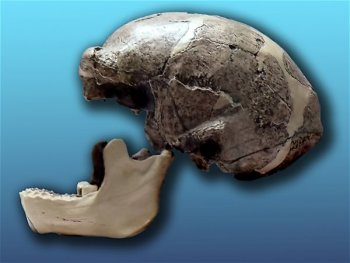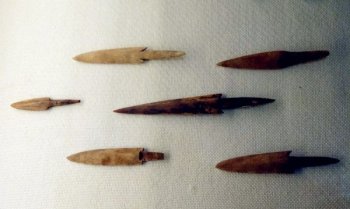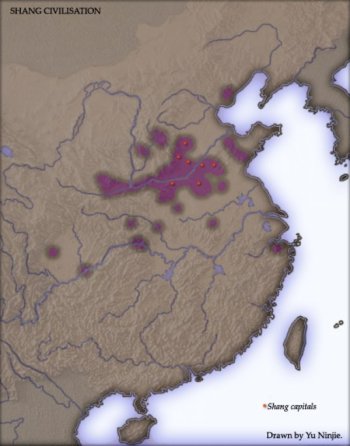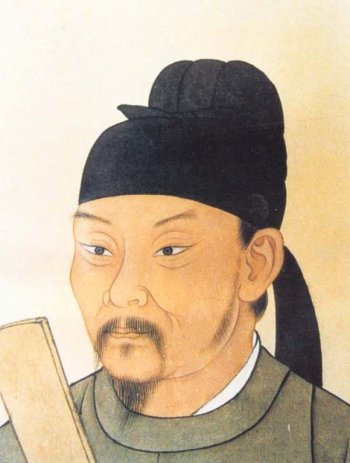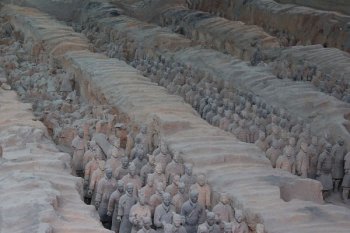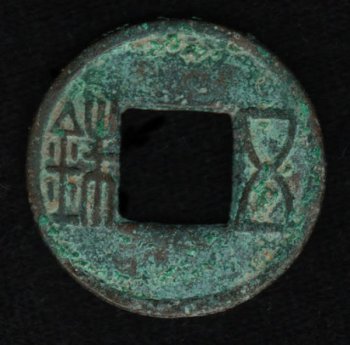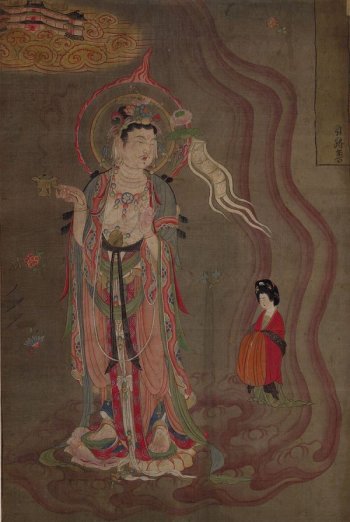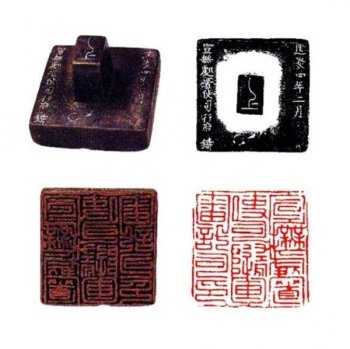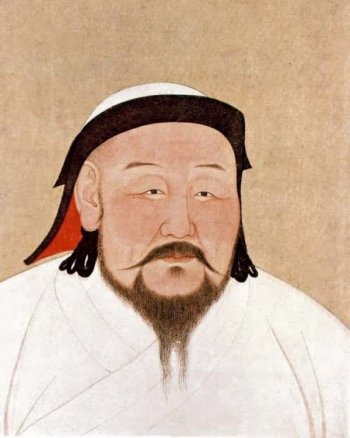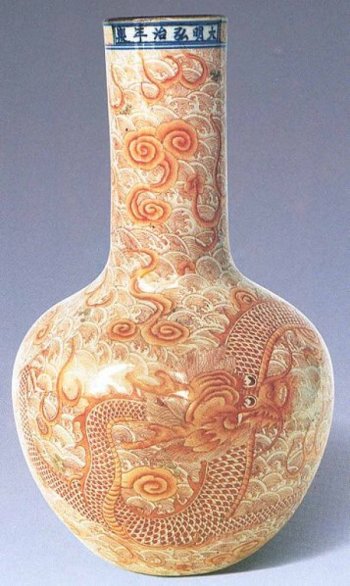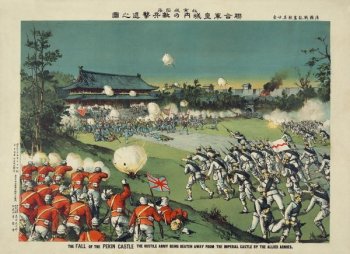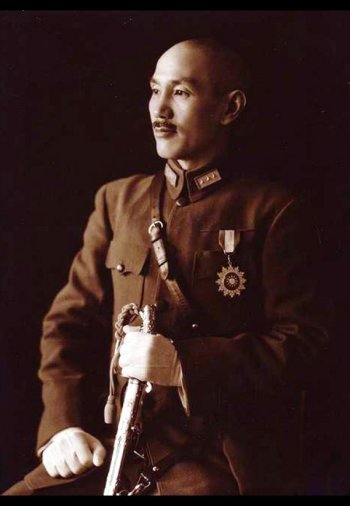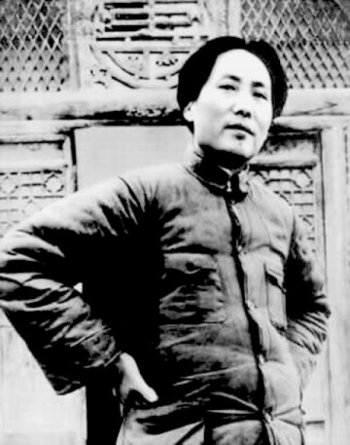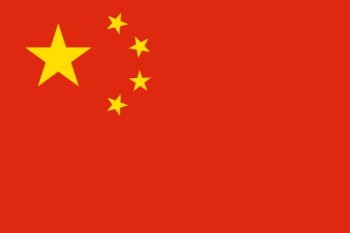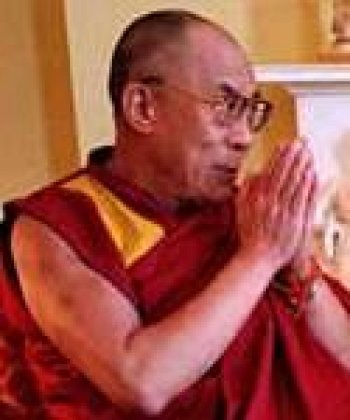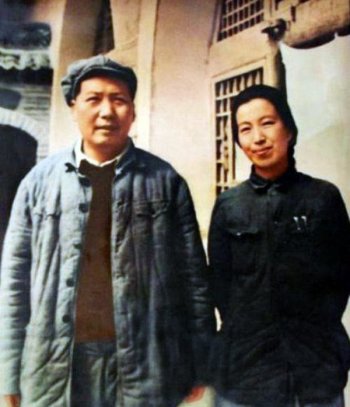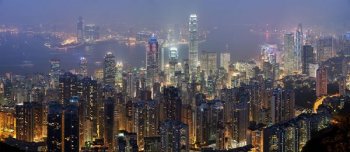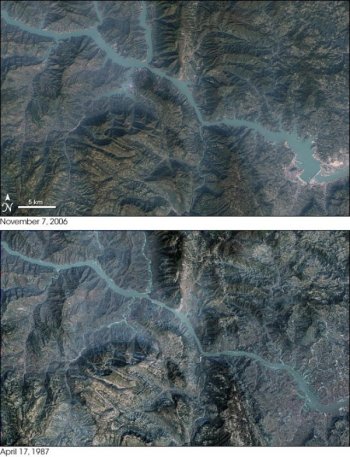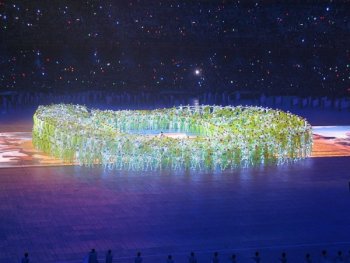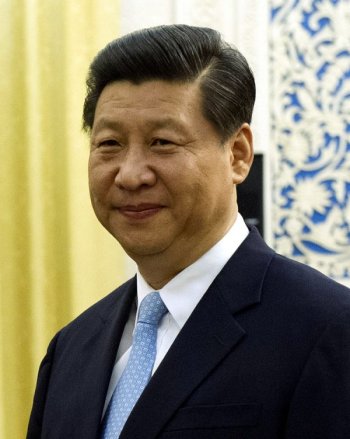History: Historical Timeline
Prehistory
| Date | Event |
|---|---|
| c. 778,000–678,000 BCE | Peking Man, as the Homo erectus specimen is later called, lives near Zhoukoudian in Central Asia. |
| 10,000–7,000 BCE | Paleolithic and Neolithic humans grow millet in semi-permanent agricultural settlements and develop the Jiahu culture. |
| 5000 BCE | Cliff carvings reveal 8,453 individual pictographs, characters that eventually form the basis of written Chinese. The Peiligang culture constructs buildings, makes pottery, and performs elaborate burials of the dead. |
| 3000–2000 BCE | Villages along the Yellow River valley appear, indicating the ability of local people to grow, store, and redistribute crops. |
Ancient China
| Date | Event |
|---|---|
| 1700–1046 BCE | The Shang Dynasty unites a large swath of north-central China and leaves the first written record of historical events. |
| 1200 BCE | Written records include divination records in ancient Chinese writing on the bones or shells of animals. These artifacts are called "oracle bones." |
| 1045–770 BCE | The Shangs overlap with and are eventually replaced by the Zhou Dynasty in northern China. The Zhou king develops the concept of the “Mandate of Heaven” to legitimize his rule—not unlike the European concept of the Divine Right of Kings—which subsequent rulers of later dynasties use to their own advantage. The downside of the "Mandate of Heaven" is that leaders are made vulnerable to overthrow by natural disasters, which imply that heaven no longer favors their rule. During the Zhou era, numerous small, regional wars undermine central rule and the dynasty slowly disintegrates. |
| 712–770 | After failing the civil service exam, poet Du Fu of the Tang Dynasty takes up the pen. His writings concentrate on morality and history, in a wide range of poetic forms. Du Fu's works become highly influential in both Chinese and Japanese literary culture. |
| 722–476 BCE | Though the Zhou Dynasty is nominally in charge, the ruler is little more than a figurehead as hundreds of small states, each controlled by a local strongman, vie for power. The era is known as the Spring and Autumn period. |
| 551–479 BCE | Philosopher, teacher, and politician Confucius promotes a philosopy of justice, moral government, and correct social relationships centered on family loyalty. One of his sayings, "Do not do to others what you do not want done to yourself," endures into the 21st century as the Golden Rule. |
| 466–221 BCE | As the smaller states gradually consolidate, seven emerge as prominent during an era known as the Warring States period. A new form of governance, called the commandery and prefecture system, takes root. The Qin king, Qin Shi Huang, eventually merges six of the seven dominant states, setting himself up as China’s first emperor. |
| 221–206 BCE | Emperor Qin Shi Huang establishes the Qin Dynasty. During his 12-year reign he builds the first Great Wall of China, but his empire does not survive his death. Though brief, the Qin Dynasty makes several important contributions to Chinese life and culture, including the first real example of a centralized government, the unification of the legal code, development of the written language, a system of standardized measurement, and a currency. Qin Shi Huang even standardizes the width of cart axles to match the ruts in roads, thus facilitating long-distance trade. |
| 206 BCE–220 CE | With no viable heir able to maintain Qin rule, the country erupts in civil war, bringing to power Liu Bang. For 400 years, the stable Han Dynasty that Liu founds presides over a cultural golden age, during which the economy prospers and Confucianism is established as the state philosophy. Buddhism first appears in China. The Han Dynasty succeeds in establishing the concept of a unified Chinese state ruled by a centralized imperial bureaucracy, a structure that endures for the next two thousand years. |
| 220 CE | With the fall of the Han Dynasty, another era of disunity arises, with regional warlords once again vying for control. Eventually, three kingdoms emerge in a period known as the Three Kingdoms, during which several powerful families gain extraordinary wealth and influence. |
| 304 | After a brief reign over a unified China, the short-lived Jin Dynasty gains power in the east and south, while the northern region is fragmented into a series of independent realms known as the Sixteen Kingdoms. |
| 420–589 | China is divided roughly in half during a period known as the Southern and Northern Dynasties. The Southern Dynasties are ruled largely by Han Chinese from their capital in Nanjing. Meanwhile, in the north the Sixteen Kingdoms gradually give way to the Northern Wei, a nomadic people. Buddhism manages to spread widely despite the divided nature of the country, with Buddhists and Taoists reaching an accommodation that allows both to flourish. |
| 589 | The short-lived Sui Dynasty rules for a scant 29 years, but it succeeds at reunifying China, instituting a national currency and the "Three Departments, Six Ministries" system that would be adopted by their successors, the Tang. The Sui also extend the Great Wall, but are weakened by all this investment and in short order the dynasty collapses. |
Imperial China
| Date | Event |
|---|---|
| 618–907 | The rise of the Tang Dynasty ushers in a second golden age of civilization; during its three-century rule, the Tangs expand their influence to central Asia and construct the second Great Wall for protection against the northern nomads. The Tang government is highly organized and efficient, run by members of the royal family, but staffed by scholar officials. Although all land is technically owned by the emperor, the Tang Dynasty distributes cultivation rights to individual families, based on household size. This system dramatically increases agricultural production. |
| 907 | A half century of disunity following the Tang Dynasty gives rise to the period known as the Five Dynasties and Ten Kingdoms, when China is a multi-state entity. Five different regimes come and go in rapid succession in the north, while in the south, ten relatively stable kingdoms hold sway. |
| 960 | Under the Song Dynasty, literature and science flourish for some 300 years, although the empire fails to develop sufficient military strength to turn back a Mongol invasion, which gradually subsumes the Songs and unifies the country. |
| 1271 | The Mongol Yuan Dynasty is ruled by Kublai Khan, grandson of Genghis Khan, who relocates the capital to Beijing. During Yuan rule, Italian Marco Polo visits China to find a restive kingdom, with peasants chafing under Mongol rule. At the time of the Mongol invasion, China’s population numbers approximately 120 million. During this period, the country widely adopts the philosophy of Neo-Confucianism, a more rationalist and secular form of Confucianism that rejects the more superstitious and mystical elements of Taoism and Buddhism. Unlike those philosophies, which see metaphysics as a catalyst for spiritual development, Neo-Confucianism uses metaphysics as a guide for developing a rationalist ethical philosophy. |
| 1368 | Urban centers grow after the Ming Dynasty drives out the Mongols, with industry producing large quantities of silk, paper, and porcelain. The agricultural economy grows stronger, providing food and money to the cities and supporting a more centralized military and administrative bureaucracy. During the Ming period, the Great Wall of China is finally completed. Foreign trade similarly expands; merchant ships ply the Indian Ocean, reaching east Africa, and conduct a brisk trade with Japan. |
| 1644 | The last imperial dynasty to rule China arrives from beyond the Great Wall and on the heels of a peasant rebellion, which creates opportunity for the Manchu Qing Dynasty. The Qing conquest of the Mings takes decades to complete and costs millions of lives. The Qing annex Tibet, Mongolia, and Turkestan, and eventually adopt Confucian tenets of governance; over time, these “foreign” invaders become as Chinese as those they had conquered. After reaching its peak of power by the end of the 18th century, the center can no longer hold. Regional warlords challenge Qing control of the distant provinces, while Western powers impose ever harsher trading terms, undermining the central government. |
| 1842 | Following its defeat by the British in the First Opium War, China cedes Hong Kong to Great Britain. |
| 1863 | The Qing attack Taiwan where remnants of the Ming Dynasty retreated and seized the rebel Kingdom of Tungning. Two and half centuries will pass before Taiwan is once again a refuge for opponents of the ruling regime. |
| 1899 | One after another, a series of rebellions further weakens the Qing Dynasty, culminating in the "Boxer Rebellion," in which Chinese opposed to increasing foreign influence attack Christians and missionaries, leading the Imperial Court to expel foreigners from the capital. An alliance of Western powers, seeking to protect its interests, invade China, only to be rebuffed. Repeated attacks on Beijing force the rulers to flee to Xi’an the following year. |
Modern Era
| Date | Event |
|---|---|
| 1912 | Severely weakened, the Qing Dynasty finally succumbs to a revolt by military officers, who seek dramatic political reforms. Upon the abdication of the emperor, the officers led by Sun Yat-sen declare the Republic of China, much to the consternation of the regional warlords, who resist. A period of instability ensues, with warlords battling one another for local power. Out of this turmoil emerges a new political force, the Communist Party, which establishes a base in southern China and an alliance with Sun Yat-sen. |
| 1919 | The May 4th Movement starts as a protest to the Treaty of Versailles, which ends World War I and awards certain German holdings to Japan. In due course, the movement transforms into the New Culture Movement, which promotes nationalism, science, freedom, and progress, and opposes feudalism, warlordism, and outdated traditionalism. Debate rages over how to advance Chinese society while maintaining Chinese identity—a uniquely Chinese left-right conflict that persists into the 21st century. |
| 1925 | When cancer claims Sun Yat-sen, his protégé, Chiang Kai-shek, breaks with the Communist Party and leads his nationalist party, the Kuomintang, to power. Chiang’s forces battle the warlords in southern and central China in a fierce and ultimately victorious military campaign. Two years later, Chiang gains the tepid allegiance of warlords in the north. He now turns his attention to the Communists, whose numbers are growing, but whose organization and military strength are still weak. |
| 1931 | Chiang’s attempt to unify the country is interrupted when Japan invades China, and, over the next 14 years, occupies ever more territory. |
| 1934 | Driven from their bases in the south and east by Chiang’s Kuomintang, a new Communist Party leader named Mao Zedong leads his followers on a "Long March" to a new stronghold in Shaanxi Province. He forms an uneasy alliance with Chiang Kai-shek’s Kuomintang to combat the Japanese, but the conflict between the nationalists and the Communists continues to simmer. |
| 1937 | Tenzin Gyatso (born Lhamo Dondrub) is selected as the 14th Dalai Lama, the religious leader of Tibetan Buddhism. |
| 1945 | With Japan’s defeat in World War II and its withdrawal from China, a brutal civil war erupts between the Communists and the nationalist Kuomintang, a battle for control of the country that lasts for four years, during which millions are killed, including many non-combatants. Mao Zedong proves to be an effective military leader and makes steady, widespread gains against the Nationalists. |
| 1949 | October 1. After years of bitter conflict, the Nationalists beat a hasty retreat to Taiwan while Mao Zedong consolidates his victory and proclaims the People’s Republic of China. |
| 1950 | When war breaks out between North and South Korea, China intervenes on behalf of the North. Tibet becomes a region of the People's Republic of China, with the Dalai Lama as its political leader. |
| 1951 | Communist activist and writer Ding Ling receives the Stalin Second Prize for Literature for her body of work that includes stories of daring and unconventional women. During her career, Ding Ling is imprisoned or put under house arrest several times for her political views. She also serves as the director of the Chinese Literature and Arts Association and writes a literary newspaper supplement. |
| 1957 | Physicist Tsung Dao Lee receives the Nobel Prize for Physics for his work in finding exceptions to the principle of parity conservation. His discoveries lead to significant advances in particle physics theory. |
| 1958 | Mao’s "Great Leap Forward" is an economic development plan intended to collectivize farming and spur industrial development. Tens of millions die in the subsequent famine, although some say that violent coercion of those deemed to be “counter-revolutionary” contributes to the death toll. The five-year program is discontinued after just two years. Mao’s heroic and effective wartime leadership 10 years earlier now comes up short as he attempts to build a society and a nation. |
| 1959 | A wide-ranging revolt in Tibet leads to a brutal crackdown by Chinese forces, which suppress the rebellion and bring Tibet more firmly under the yoke of Chinese control. The Dalai Lama flees to India, where he continues teaching Tibetan Buddhism and advocating for the Tibetan people. |
| 1966 | Seeking to restore his central role in Chinese government, Mao initiates the Cultural Revolution, a campaign of social and political reform designed to root out remnants of capitalism and further instill Communist ideals in the Chinese consciousness. Mao purges, often violently, the government and party leadership of “revisionists” and ignites factional struggles across the society, from the military to industry to the top leadership of the Communist Party. Millions are displaced through forced relocation to rural areas. Though hardliners argue that the Cultural Revolution is necessary to preserve the socialist character of China, many see it as a setback to China’s economic development and another miscalculation on Mao’s part. |
| 1967 | After studying for years under Wing Chun, master martial artist Yip Man opens the Ving Tsun Athletic Association, a school for martial arts training. Yip Man develops a reputation as one of the most respected martial artists of his time, and international fame as the teacher of Chinese-American actor Bruce Lee, who features the art form in the US film industry. |
| 1972 | Partly to counter the Soviet threat to the United States, President Richard Nixon makes a historic visit to China, during which the two nations state their interest in normalizing relations. |
| 1976 | The death of Mao Zedong marks a turning point in China. His widow, part of a group dubbed the "Gang of Four," attempts to take power, but is arrested and convicted of crimes against the state. |
| 1977 | The reformist leader Deng Xiaoping maneuvers into a position of power. Though he is neither head of the Communist Party nor head of state—he is known simply as the Paramount Leader—his ascendance marks a dramatic change in policy, including the dismantling of the Cultural Revolution, the embrace of rapid economic development including limited private enterprise, and modest progress on civil liberties. Collective farms are distributed to the peasant farmers in the form of land leases, with an immediate increase in agricultural production. Market reforms enable private ownership of small business. Government control over the citizenry is also loosened, granting more individual freedoms to the populace. |
| 1979 | The People’s Republic of China and the United States establish formal diplomatic relations. The same year, the government initiates its one-child policy in an effort to rein in rampant population growth. |
| 1986 | China promotes an "open-door policy" that encourages foreign investment, sends tens of thousands of students to Western universities, and further develops the country’s growing private sector. Though the Communist Party maintains tight political control, the nation’s economy is increasingly privatized, with the state maintaining control of key industries but allowing private enterprise to flourish. |
| 1989 | A nascent democracy movement brings thousands of demonstrators to Tiananmen Square in central Beijing, where they camp for weeks, demanding the posthumous rehabilitation of former Communist Party General Secretary Hu Yaobang, who was driven from office two years earlier on charges of “bourgeois liberalism” for his call for more far-reaching political reforms. The demonstration is brutally suppressed when Chinese troops open fire on the demonstrators. The government places the death toll at 200, but eyewitness accounts estimate it as high as several thousand. Jiang Zemin succeeds Zhao Ziyang as Chinese Communist Party general secretary when Zhao refuses to impose martial law during the Tiananmen crisis. |
| 1997 | Upon expiration of its 99-year lease, Great Britain returns Hong Kong to Chinese control. |
| 1998 | Actor and martial artist Jackie Chan stars in the Hollywood blockbuster, Rush Hour, propelling him to worldwide fame. He goes on to star in numerous action and drama films before, frustrated with the limited roles he is offered, he starts his own production company. |
| 2000 | The government initiates a crackdown on official corruption and executes a former deputy chairman of the National People's Congress for bribery. |
| 2001 | China joins the World Trade Organization (WTO). The World Trade Organization establishes the rules of trade between nations and works to ensure international trade occurs freely. |
| 2002 | China continues to declare their military stance toward Taiwan is purely defensive. The United States argues that China is modernizing their military and moving toward forcefully reincorporating Taiwan into China. |
| 2003 | China's first manned rocket, carrying astronaut Yang Liwei, is sent into space. |
| 2005 | A chemical plant alongside the Songhua river explodes contaminating the water supplies of millions of people. |
| 2006 | China completes construction of the controversial Three Gorges Dam, the world’s largest hydro-electric power source, which causes the destruction of hundreds of villages and towns, some of which are deemed important cultural heritage sites. |
| 2008 | China quells violent protests in Tibet just months before the Summer Olympic Games open in Beijing. May. A disastrous earthquake kills tens of thousands in Sichuan province. Despite concerns over poor air quality in the capital, the Olympic Games showcase a modern, industrialized China that claims its place as a major global superpower. Less than two months after the Olympics, a Chinese astronaut, Zhai Zhigang, successfully completes the country’s first spacewalk, which takes place during China’s third manned space mission. |
| 2010 | A 17.7 percent rise in exports makes China the world’s largest exporter, displacing Germany. Later in the year, imprisoned Chinese dissident Liu Xiaobo receives the Nobel Peace Prize. |
| 2011 | China is officially the world’s second-largest economy, displacing Japan. |
| 2012 | January. Official figures state that city dwellers outnumber the rural population for the first time. June. The country completes the first ever manual docking of a spacecraft with another space module. China's first female astronaut, Liu Yang, takes part. |
| 2013 | China relaxes its one-child policy and abolishes “re-education” by means of forced labor. |
| 2014 | In the first case of its kind, the US charges five Chinese army officers with industrial cyber-espionage. |
| 2015 | China's economic growth slows to 7.4 percent annually, the slowest rate of expansion in more than 20 years. |
| 2016 | China's one-child policy comes to an end after 35 years. Families are now allowed to have two children. Critics of the one-child policy are optimistic that the policy has been loosened but continue to argue that all restrictions should be removed. |
| 2017 | The country claims to have won a weeks-long border dispute with India, which it says was trespassing in a disputed Himalayan border area; Indian troops pull back. |
| 2018 | April. Responding to US tariffs on 1,300 Chinese products, the country will now impose a 25 percent tariff on 106 US goods. China's influence within the UN grows; it is now the second biggest funder of the organization, following only the United States. Activists and critics worry the nation is systematically weakening the ability of the UN to protect human rights worldwide, while simultaneously pressuring the UN toward acting in China's best interest. |
| 2020 | January 9. The World Health Organization announces that a deadly coronavirus has emerged in Wuhan, China. In a matter of months, the virus causes a pandemic that spreads across the globe. June. In an unprecedented move—and after saying they repeatedly expressed their concerns—50 independent United Nations experts issue a joint statement calling for the government of China to stop the repression of "fundamental freedoms," and “abide by its international legal obligations.” Issues cited by the statement include: repression of protests and democracy advocacy in the Hong Kong Special Administrative Region; excessive use of force by police; alleged sexual harassment and assault of women protesters in police stations; alleged harassment of health care workers; allegations of forced labor; arbitrary interference with the right to privacy; cybersecurity laws that authorize censorship; anti-terrorism and sedition laws applicable in Hong Kong; concern for journalists, medical workers, and others speaking out about COVID-19, and the repression of specific communities, particularly religious and ethnic minorities in Xinjiang and Tibet. China passes a new National Security Law for Hong Kong, which would punish secession, subversion, terrorism, and “collusion with foreign forces," with maximum penalties of life imprisonment. Human Rights Watch calls the move China's "most aggressive assault on Hong Kong people’s freedoms since the transfer of sovereignty in 1997," while Amnesty International calls out the vague and broad definitions, where "virtually anything could be deemed a threat to national security." The law comes after six months of 2019 pro-democracy protests in Hong Kong against the Chinese government and its extradition bill, which was later revoked. July. Election authorities in Hong Kong disqualify a dozen pro-democracy figures from elections set for September, citing collusion with foreign forces and opposition to China's National Security Law. |
| 2021 | May. Aiming to boost the country's birth rate, China revises its laws to allow couples to have three children, and does away with fines imposed on people who fail to comply with the limit. The move comes after the 2016 revision to the country's one-child policy—which lasted 10 years and allowed two children per family— failed to increase the birth rate. August. Aiming to combat what authorities call, "youth video game addiction," China imposes a 3-hour-a-week limit on gaming for youth under age 18. November. The new Beijing Stock Exchange launches, aimed at helping small and medium-sized businesses and innovative firms raise money. |
| February 2022 | Beijing hosts the 2022 Winter Olympics. The International Olympic Committee says the games are "the most digitally engaged Olympic Winter Games ever, with billions of engagements across digital platforms," with over 600 million people watching by television. Seven new events are added to the games, including: Women’s Monobob, Men’s and Women’s Big Air (Freestyle Skiing), Mixed Team Snowboard Cross, Mixed Team Aerials, Mixed Team Short Track Relay, and Mixed Team Ski Jumping. |
Copyright © 1993—2025 World Trade Press. All rights reserved.

 China
China 